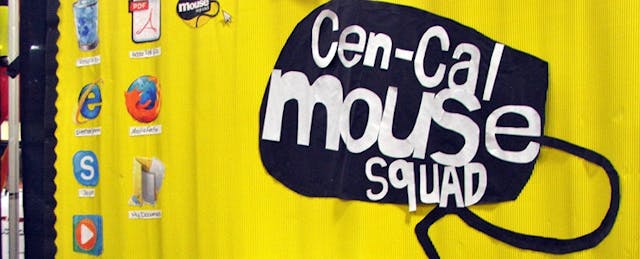It’s been a fertile few years for youth development nonprofits with a techie bent. So many groups want to teach kids how to code that EdSurge just published a guide.
Of course, that was far from the case in 1997, when MOUSE began operating. Originally founded to bring Internet access and computers to underserved schools, the New York-based nonprofit shifted gears in 2000 and started teaching tech skills to middle and high school students. Today, MOUSE trains students in 377 schools across the country and runs a yearlong afterschool tech design program for about 25 New York City high schoolers.
On Monday, MOUSE celebrated its longevity and evolution with a 15th anniversary bash at Manhattan’s Chelsea Piers. Around 400 people showed up, representing technology, business, politics and education sectors. MakerBot CEO Bre Pettis, angel investor Joanne Wilson and New York City Council Speaker Christine Quinn received awards for their support of MOUSE and gave speeches.
Despite the big names in attendance, MOUSE students were the event’s stars. More than 30 came and formed a makerspace where they demo’ed projects. The most interesting work came from MOUSE Corps, MOUSE’s New York tech design program, which develops a new set of socially-conscious technologies each year.
This year, MOUSE collaborated with United Cerebral Palsy of New York City to create assistive devices. Projects included ‘Mixing Buddy’, a programmable stand that holds a hand mixer and bowl steady for cooking; ‘Art2’, an assistive painting and drawing device; ‘Joypix’, a digital camera apparatus that accommodates special motor needs; and ‘Extend-a-arm,’ an electronic claw device that attaches to crutches and wheelchairs to retrieve objects from the floor.
The makerspace also featured robotics, serious games and 3D printing projects. MOUSE covers those topics in its MOUSE Squad program. MOUSE Squad primarily trains students to act as their schools’ tech helpdesks, but has expanded in recent years to include robotics, circuitry and game design. MOUSE Squad members like the hands-on activities and MOUSE likes having multiple ways to teach real-world problem-solving.
MOUSE thinks of itself as more STEAM than STEM. (The 'A' standing for arts.) It wants to cultivate life and work smarts rather than specific technical skills. “The tools we use are often leading-edge technologies, but MOUSE is about inquiry-based, human-centered design,” said Executive Director Daniel Rabuzzi in an interview.
To create their assistive technologies, MOUSE Corps members interviewed people with cerebral palsy about their daily routines. The students also did empathy exercises to better understand the challenges of limited mobility. After brainstorming project ideas, they spent several months creating prototypes in small groups and refining their designs.
MOUSE supporters believe this holistic approach prepares young people to not just enter, but also lead the workforce. Christine Quinn said she expected to see MOUSE grads become CEOs within the next 15 years. Joanne Wilson called MOUSE members “the next generation of entrepreneurs.” Rabuzzi said MOUSE grads would create companies that will eventually employ thousands of people.
MOUSE members weren't outlining their 15-year-plans at the event, but said they would do something technology-related. Asked about likely college majors, the teens mentioned aerospace engineering, computer science, industrial design and product design.
MOUSE’s 15-year ambition is to extend its reach, in the U.S. and abroad. It currently works with about 4,250 students. At the anniversary event, MOUSE Chairman Brian J. Miller declared, “We want a MOUSE program in every underserved school across the country and beyond!” Wilson suggested MOUSE should be mandatory in American middle and high schools.
To fund its growth, MOUSE is courting support from technology companies both large and small. Best Buy, which received an award at the event, has given MOUSE more than $2 million over the past 10 years via its Children’s Foundation. Makerbot has donated 30 3D printers to MOUSE since 2011. (The printers teach kids “how to innovate and iterate,” said Pettis at the event, adding, “What I see here inspires me to do more.”) MOUSE is also interested in licensing its online curricular tools to companies.
To significantly expand MOUSE, schools will need to pitch in. MOUSE charges schools $1,000 a year to be part of MOUSE Squad. Schools can often cover the cost with grant money but it’s up to them to apply for grants.
One issue for MOUSE is schools have more technology resources than ever. MOUSE points out that MOUSE Squad helps schools by training students in IT. In some schools, MOUSE Squad is the only tech support. In others, it augments professional tech support. Either way, it can save money and teachers' sanity.
Teachers at the event said MOUSE also stands out as an edtech tool. “You get curriculum and a national community of users,” said Lou Lahana, who has used MOUSE to teach 3D design, photo and video skills to middle schoolers at The Island School in Manhattan. (Some lucky MOUSE schools, including Lahana’s, also get MakerBot printers.) Without MOUSE, “you would have to come up with most of this yourself,” said Lahana.


